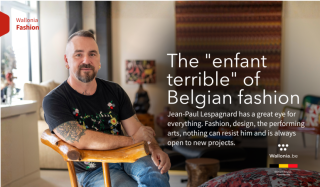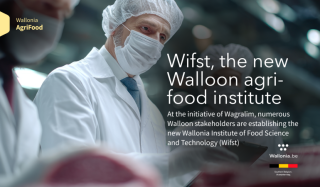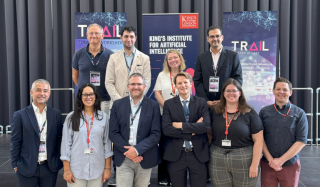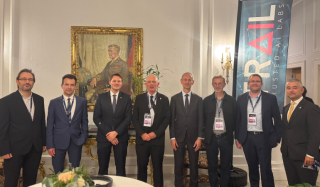The life-science ecosystem of Wallonia (Southern Belgium) was showcased at the LSX World Congress by a panel of experts: Benoit Kenda, VP and Early Solution Partnering Head at UCB; Amel Tounsi, CEO of Bridge to Health; and Marc Foidart, Executive Chairman of EyeD Pharma.
What are the strengths of our ecosystem that helped you thrive in Wallonia?
B. Kenda: We are major investors in Belgium, particularly in the Walloon ecosystem. We allocate around 30% of our revenues to Research and Development. We have three sites globally: one in the UK, one in the US, and one in Belgium, where we primarily focus on biopharmaceuticals. From our experience, Wallonia represents an appealing ecosystem to invest in.
M. Foidart: Representing EyeD Pharma, we develop, design, and manufacture micro-implants in polymers, which deliver a sustained release of Active Pharmaceutical Ingredients (APIs). We produce three types of technology, mainly focused on ophthalmology, with releases ranging from day one to up to nine years. Our team includes 75 people, and we can attest that the Walloon ecosystem has many strengths that have supported our company’s growth.
The attractiveness of a region is always tied to its ability to secure investments. In Wallonia, we have leveraged our equity and raised substantial non-dilutive funding. So far, we have secured 17 million euros in funding, with another 24 million pledged over the next five years.
Thanks to the Walloon government’s policies, our company has accessed key non-dilutive funding, allowing us to de-risk at the early stages of our development and attract other investors.
A. Tounsi: When starting a company, innovation opportunities are crucial. In Wallonia, we have built an ecosystem comprising 11,000 researchers, 5 universities, and several spin-off companies. We attract investors from Wallonia and Belgium as a whole because they see opportunities for both non-dilutive and dilutive funding.
Focusing on a success story, how did Syndesi Therapeutics thrive in our ecosystem?
B. Kenda: Investors find Wallonia appealing for several reasons: (1) access to funding for pharmaceutical research, especially in its early stages; (2) access to talent, as the region is investing heavily in educating 7,500 new researchers over the next 10 years; and (3) a wide scope of expertise across clinical research.
Several years ago, at UCB, we developed Syndesi Therapeutics, and I was part of the founding team. It was an exciting time; we managed to attract global investors and significant investment from the Wallonia region. This company was acquired by AbbVie, the British pharmaceutical R&D company, for a significant amount. The success was due to its assets and the investment team’s efforts.
What is the ecosystem doing to address the challenge of producing talent within the region?
A. Tounsi: Organizations like Bridge to Health and other backbone structures of our ecosystem are aligned on this aspect. In the region of Liège, we have grouped all the actors focused on life science training, both university and technical.
We identified two main issues: dual training and new training techniques. Compared to our neighbours, we offer fewer opportunities for dual training, which combines training talent on-site with initial training in high schools or universities. Additionally, we need to design shorter, more flexible training programs that fit the ecosystem's needs.
An ongoing project is centred around European biotech companies, with developments expected in the region soon.
B. Kenda: The EU biotech campus is still in its early stages, but it rests on two pillars: developing EU biotech talent, particularly in Advanced Therapy Medicinal Products (ATMPs), and providing on-site and off-site training. This will introduce researchers to labs and offer long training sessions digitally.
M. Foidart: We have faced challenges in both retaining and training our teams. Retaining talent is crucial, and we have recruited highly skilled individuals by collaborating with the ecosystem. It’s important for us to have an ecosystem capable of training the right talent and creating an environment that encourages their retention in the region.
While we are proud of the Walloon ecosystem, we also recognize the strength of working together with other ecosystems.
What collaborations have you developed between Belgium and the UK?
M. Foidart: At EyeD, we focus on clinical collaborations, primarily working with two hospitals in the UK: Moodfields Eye Hospital in London and Manchester Royal Eye Hospital.
B. Kenda: We have several established collaborations, including a major site in Slough, near London, focusing on antibody and immunology research, and a new site near Maidenhead and Windlesham. We also collaborate with leading organizations such as Holliston, UCL, and KCL in oncology and other areas.
A. Tounsi: Bridge to Health participates in all the biotech conventions in the UK and organizes events in Wallonia. Our next event is on May 23rd, where we invite regional investors to connect with the funds and angel investors, they work with to spotlight 12 Walloon companies.
What would you recommend as a structuring strategy to maintain our attractiveness and competitiveness?
M. Foidart: Government-sponsored VCs like Noshaq should foster a structured investment policy with other VCs and foreign VCs. This connects different investors and creates a wider ecosystem.
B. Kenda: From a pharmaceutical perspective, it’s crucial to continue growing talent, fuelling research, and strengthening university collaborations. We need to boost lab capabilities and provide more space for startups to grow rapidly. Acquiring a critical mass of financing loans and avoiding multiple investment strategies by partnering with major investors will help raise funding.
A. Tounsi: As a leader of Bridge to Health, I envision our life science ecosystem as organized and united within Wallonia. We have an edge in ATMPs, and as a network organization, we need to ensure all parties communicate effectively along our value chain and fill gaps. Building international collaborations and attracting companies to settle in the region, especially in fields where we excel, is essential.
What are some examples of investments made by the region?
A. Tounsi: The region has invested significantly in infrastructure. The government understands that to establish cooperation, we need adequate space and resources. In Liège’s Les Liégeois Park, we now welcome many companies within our ecosystem that needed space to grow, including companies from outside Wallonia.
M. Foidart: Funding the space where we design, develop, and manufacture micro-implants with a proprietary process was key to our development. We created a special purpose vehicle where public authorities funded a large part of the equity, which we leveraged with banks. This enabled us to design our manufacturing sites with 25 million euros in investments. We wouldn’t have achieved this in another ecosystem.
B. Kenda: It’s worth mentioning that ATMPs have developed significantly. We have had two major investments supported by the Walloon region: the recently inaugurated pilot plant in Braine-l’Alleud and the development of the cell and gene therapy site.



